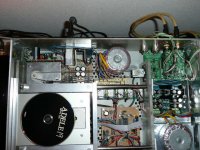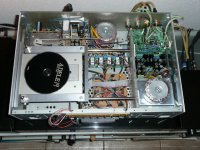Re: TP cd Player up and running
Some context would be good - in comparison to what please?
muizel said:Sound is fantastic thanks Russ and Brian !
Some context would be good - in comparison to what please?
Re: Re: TP cd Player up and running
Hello Studley,
I spend a lot off time to listen between my Sphinx project nine
and Philips SACD1000 with APL modification, not alone but with friends and my wife , we all agreed that the sound was much more detailed and 3d without fatigue, you can listen the whole day long without feeling the need to lower volume or get irritated.
Anyway I am very happy.
😀
Studley said:
Some context would be good - in comparison to what please?
Hello Studley,
I spend a lot off time to listen between my Sphinx project nine
and Philips SACD1000 with APL modification, not alone but with friends and my wife , we all agreed that the sound was much more detailed and 3d without fatigue, you can listen the whole day long without feeling the need to lower volume or get irritated.
Anyway I am very happy.
😀
Hi Russ and Brian ,
I ve sent you an email to orderstatus at twistedpear.
Have you received it?
Vitaly
I ve sent you an email to orderstatus at twistedpear.
Have you received it?
Vitaly
tubesguy said:Now I just need to find a few 10nf caps for the IVY mod, and then sit back and try to keep from screwing around with it too much more. - Pat
To follow up, the Capacitor Fairy left some of the appropriate caps in my mailbox yesterday (apparently accompanied by the Zero-Ohm Jumper Fairy) and I did the modification to the IVY last night, after allowing the caps to assume room temperature. (It's kind of cold in Wisconsin right now.)
A satisfying improvement, I thought, although I had been very impressed with the unmodded IVY. I'm not much up on the audiophile lingo, but I'd definitely say that a veil or two has been dropped, and the highs had gone from (comparatively) steely and bright to a wonderful caramel color (flavor?). Of course, the Buff in now ruthlessly revealing of any deficiencies in the source material. 😉
Thanks again guys, for a great product and great service. - Pat
What is the purpose of the opamp buffer for the analog supply
OK, this is my (limited) understanding of the analog power path.
the regulator buffer looks like a voltage follower preceded by a CRC filter. So the CRC filters the high frequency noise and the voltage follower just passes the remaining noise to the DAC supply pins?
The input to this buffer is output of the analog LDO regulator. Most regulators have noise figures in the 10s-100s uV.
So, if the local LDO noise figure is inherent in the device, how can cleaning the upstream noise (e.g. TPA dual PS) reduce this noise?
In other words, if you chain several regulators, you can improve load and line regulation, but is the output noise dominated by the noise of the last regulator? Thus it seems to me that the noise of the local LDO filtered by the CRC is the inherent noise of the buffalo analog supply line. (Plus the noise of the opamp but this is probably in the nV range)
OK, this is my (limited) understanding of the analog power path.
the regulator buffer looks like a voltage follower preceded by a CRC filter. So the CRC filters the high frequency noise and the voltage follower just passes the remaining noise to the DAC supply pins?
The input to this buffer is output of the analog LDO regulator. Most regulators have noise figures in the 10s-100s uV.
So, if the local LDO noise figure is inherent in the device, how can cleaning the upstream noise (e.g. TPA dual PS) reduce this noise?
In other words, if you chain several regulators, you can improve load and line regulation, but is the output noise dominated by the noise of the last regulator? Thus it seems to me that the noise of the local LDO filtered by the CRC is the inherent noise of the buffalo analog supply line. (Plus the noise of the opamp but this is probably in the nV range)
Re: What is the purpose of the opamp buffer for the analog supply
The main purpose is to provide a very low supply impedance the analog pins of the device. 🙂
Also, If you look at the spectrum of the noise which needs to be filtered it is all (or rather nearly all) high freq. (80 and 160mhz mostly) 🙂 The scheme used actually provides a cleaner AVCC then I had actually hoped. If you want to extend the filter even lower you can parallel the cap with 100uf or so. But in practical tests it made little difference if any. 🙂
Cheers!
Russ
glt said:OK, this is my (limited) understanding of the analog power path.
the regulator buffer looks like a voltage follower preceded by a CRC filter.
The main purpose is to provide a very low supply impedance the analog pins of the device. 🙂
Also, If you look at the spectrum of the noise which needs to be filtered it is all (or rather nearly all) high freq. (80 and 160mhz mostly) 🙂 The scheme used actually provides a cleaner AVCC then I had actually hoped. If you want to extend the filter even lower you can parallel the cap with 100uf or so. But in practical tests it made little difference if any. 🙂
Cheers!
Russ
Joshua_G said:What is the gain of the IVY Balanced Linestage?
0db from the DAC results in an output of ~2 VRMS.
Russ White said:
0db from the DAC results in an output of ~2 VRMS.
Which makes a gain of how many dB?
Joshua_G said:
Which makes a gain of how many dB?
when you have current in and voltage out . . .
how can you define gain ?
Joshua_G said:
Which makes a gain of how many dB?
Compared to what?
2VRMs is 0db output from the DAC. I don't know how else to put it. 🙂
In simple terms an I/V stage does not have gain so much as a ratio of current to voltage.
In this case for the max swing of about 16ma peak to peak you get 2V RMS. Which happens to be the standard for consumer level signals.
I hope that helps.
Russ White said:
Compared to what?
2VRMs is 0db output from the DAC. I don't know how else to put it. 🙂
In simple terms an I/V stage does not have gain so much as a ratio of current to voltage.
In this case for the max swing of about 16ma peak to peak you get 2V RMS. Which happens to be the standard for consumer level signals.
I hope that helps.
Well, I intend to replace the Ivy with discreet JFET amp, which is actually a voltage amplifier, to which I need set a gain, but I have no clue what gain.
Joshua_G said:
Well, I intend to replace the Ivy with discreet JFET amp, which is actually a voltage amplifier, to which I need set a gain, but I have no clue what gain.
Ahh ok, well the voltage output of the DAC is just above 2VRMs. So I would just go unity gain.
If your JFET cct has a high input impedance then you will be using the DAC as a voltage source, not a current source. you will lose a bit of dynamic range and THD will go up a tad, but it can still sound excellent.
Cheers!
Russ
Hi Brian/Russ
You got my address wrong on the shipping package, sent you guys an email with the details!
You got my address wrong on the shipping package, sent you guys an email with the details!
Hi Brian/Russ You got my address wrong on the shipping package, sent you guys an email with the details!
Please use email for this type of thing. Your address has been corrected before shipping.
I was thinking of using shunt regs for the Buffalo. Is there an added benefit of the opamp to regulate voltage or can it be bypassed with a shunt reg? Would a pair of BG NX 220uF in super-E config in place of the lytic and bypass caps for the analog yield any improvements? I guess I am asking, if I was to upgrade any key parts which would they be. The analog coupling caps is one I thought would help.
Just received the v1.2 Buffalo. USPS Priority comes in a big envelope and takes longer than ordinary air mail! (13 days).
I can confirm that the new comparator works up to 192k



I can confirm that the new comparator works up to 192k



Sorry guys,
I'm just about to put in a mouser order.... could someone tell me again the correct form factor and type for the comparator chip? I was going to add the newer one into mine at some stage...
something tells me it was SOT23?? Is that right?
I'm just about to put in a mouser order.... could someone tell me again the correct form factor and type for the comparator chip? I was going to add the newer one into mine at some stage...
something tells me it was SOT23?? Is that right?
- Status
- Not open for further replies.
- Home
- More Vendors...
- Twisted Pear
- Buffalo DAC (ESS Sabre 9008)

